Halloween is a season within a season, filled with costumes, community spirit, autumn decorations, and, of course, candy. Whether we’re talking candy corn, Snickers, Reeses, Hershey bars, or Good n’ Plenty, candy and Halloween go hand-in-hand.

But beware of that wicked witch circling overhead. Also known as Diet Culture, she loves nothing more–even on Halloween– than to put the kibosh on fun and freedom.
The Dilemma of Halloween in Sugar-Phobic, Thin-Minded Diet Culture
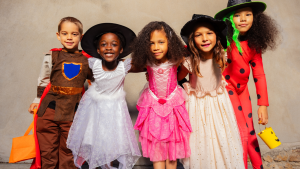
Trick-or-treating for candy in a costume is a rite of passage for most children. So much so that costume-planning often starts before the school year does. It can be exciting and pure fun to hide behind an alter-ego while getting rewarded with sweets.

Thanks to Diet Culture messages, however, Halloween also brings anxiety and trick-or-treating guilt. The anxiety and guilt aren’t about scary witches or goblins, but the goodies doled out into our plastic pumpkins.
Which candy should you eat? Which candy should you give away? Will eating a piece of candy make you fat or be the start of a binge?
What if you were to eat just one piece? (But then again, most Halloween candy comes in bite-sized portions. So it’s not really like eating a candy bar unless you eat a bunch of pieces. Or is it?)
If eating candy is bad, are you bad for eating some?
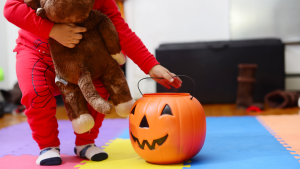
It can all feel way more complicated than it is.
As a psychologist specializing in disordered eating and eating-disorder recovery, I understand that the sight of bags overflowing with candy can be intimidating.
It’s no wonder parents wrestle with managing their children’s (and their own) candy consumption while also trying to create fun memories and experiences.
After all, It’s natural to be concerned about an influx of treats. All those little goblins staying up past their bedtime because of a sugar high? The mere thought must be haunting to parents.
Especially at times like Halloween, most of us want children to have fun. But “fun” means ignoring Diet Culture rules. And that can feel like a big ask because enjoyment of food is so contradictory to society’s standards for unrealistic thinness.

We have to learn to rebuild trust with food.
Diet Culture has taught us many strategies to deal with Halloween candy:

- Programs like the Switch Witch encourage children to trade candy for toys.
- Dental offices hold candy-buy-back events.
- And other community initiatives seek to help parents manage their kids’ candy supply.
It’s an ironic concept, when you think about it: spend a small fortune on candy, hand it out, then take it back. What are we really saying to our kids?
And where does all that expensive candy end up?
I empathize with parents’ dilemma. So much conflicting information out there, and it all seems to converge on one fun holiday.
I am passionate about fostering a healthy relationship with food and want to emphasize a crucial point: The mindset surrounding Halloween (and non-Halloween-related) treats has lasting effects on our relationship with food and our bodies, especially for children.

Your own experiences with candy growing up influence how you approach Halloween season.
Many recall homes where sweets were hidden or rationed, creating an environment of scarcity and anxiety around food. Perhaps this culminated in cycles of deprivation and binge-eating that were difficult to break.
These experiences lead to a complicated relationship with candy and other treats as adults — one that often includes feelings of guilt, restriction, and/or shame.
When you deem sweets to be forbidden, they naturally become more enticing.
The result?
A lifetime of trying to follow Diet Culture food rules, which are a setup for disordered eating, body-image problems, anxiety, and low self-worth.
The cycle of deprivation can contribute to binge-eating behaviors or other problematic relationships with food.
Shifting the Narrative on Treats, Halloween or not
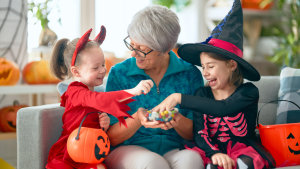
The truth is that when treats, snacks, and sweets aren’t viewed as “bad” or “off-limits,” they lose their power over you.
Children (actually, people in general) “allowed” to enjoy treats at Halloween learn to listen to their bodies and discover their hunger and fullness cues: essential skills for lifelong well-being.
This ability to tune in to our own needs is invaluable, especially in a culture that often promotes restrictive eating patterns.
Acknowledging the anxiety

It’s completely natural to feel uneasy when faced with the prospect of candy-filled bags pouring into your home.
- How many treats will my kids consume?
- How do I manage their sugar highs and crashes?
- How do I convey the importance of moderation without instilling fear or guilt?
As I mentioned, you have your own history of struggles with food, and that can make it tough to navigate this time of year.
The challenge is even greater if you’re also preoccupied with how you will navigate the temptation to eat your children’s candy.
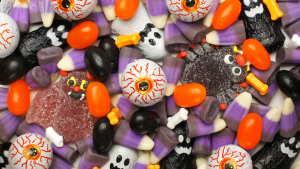
Rethinking treats
To break this cycle, it’s essential to shift perspective on Halloween candy (and all Diet Culture’s “forbidden food” rules).
When you frame candy and snacks as forbidden, you inadvertently place them on a pedestal, making them even more desirable. Your mind becomes filled with food noise.
You do have a choice, however, even though you may not see it that way.
You can choose to foster a healthier relationship with foods – even candy – by allowing your children the freedom to enjoy them without guilt.

(Did I just hear a gasp of terror?)
My advice is to focus more on balance than deprivation.
Allow your children to enjoy their Halloween treats without shame or anxiety. When they feel free to eat candy, they consume what they truly want and need. They lose the compelling urge to gorge themselves whenever the opportunity arises.
7 Strategies for Celebrating Halloween with Freedom, Fun, and Flavor. Not with Diet Culture.

- Normalize treats:
Encourage a mindset in which sweets are seen as a normal part of life rather than as something to be hidden away or feared.
Allow your children to enjoy Halloween candy without restrictions, creating an atmosphere of acceptance.
When children understand that it’s perfectly okay to have treats occasionally, they’re less likely to approach them with anxiety.

Food is just food. Candy is just candy. No biggie.
- Model healthy behaviors:
Children learn by example. If they see parents enjoying a piece of candy without guilt, kids are more likely to adopt a similar mindset.
Show them how to enjoy treats. No deliberate compensation is needed.
- Encourage intuitive eating:
Teach your children to listen to their bodies’ hunger cues. Rather than mindlessly munching on candy, encourage them to think about what they want.
Ask questions like, “What candy do you enjoy the most?”
This can help them tune into their cravings and appreciate the experience.
- Create balance:
Halloween doesn’t have to be an all-or-nothing scenario. When children start the night feeling satisfied and nourished, they may feel less compelled to overindulge once the candy comes into play.

- Emphasize fun over food:
Focus on the non-food aspects of Halloween: dressing up, carving pumpkins, and spending time with friends and family.
By shifting the focus away from candy and toward the overall experience, you create lasting memories that aren’t solely centered around treats.
- Maintain open communication:
Talk openly with your children about food, fun, and the joy of eating food of all kinds.
Share with them that enjoying treats is okay and that their worth is not determined by what they eat.
This can help normalize conversations around food and reduce the stigma associated with eating something “unhealthy.”
- Understand your own history:
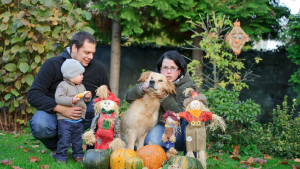
If Halloween triggers discomfort, reflect with self-compassion on your “diet rules” and own relationship with food and body image. Are there remnants of diet mentality from your past that you’re bringing into your parenting?
Breaking this cycle can be incredibly freeing for you and your children.
If Halloween triggers discomfort related to your own eating history or body image issues, take some time to explore those feelings.
Are you carrying over-restrictive beliefs from your own childhood? Do these beliefs influence how you interact with food and treats today?

Halloween can bring up complex emotions around food.
It also offers us a beautiful opportunity to teach children about balance, joy, and other important messages.
By creating an environment where treats are part of life, you can help children build a positive relationship with food (and with other people) that lasts a lifetime.
And, by nurturing a healthier mindset within yourself, you will pass on more positive lessons to your children.
The Takeaway?
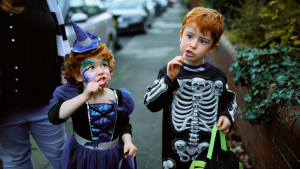
Enjoy treats! Consider them “fun foods.”
Creating a positive environment around food, complete with celebration and no shame, sets children up for an attuned relationship with their bodies and food.
Halloween is just one day of the year. But what you teach and model about food, joy, and balance can last a lifetime.

Make Halloween a time that is free from Diet Culture guilt and anxiety. Let it be about fun and connection.
Dr. Elayne Daniels is an international coach, consultant, and psychologist specializing in eating disorders, body image, and High Sensitivity. She is anti-diet, Intuitive Eating certified and passionately believes comfort in your body at any size is your birthright. Contact her here for more information.
